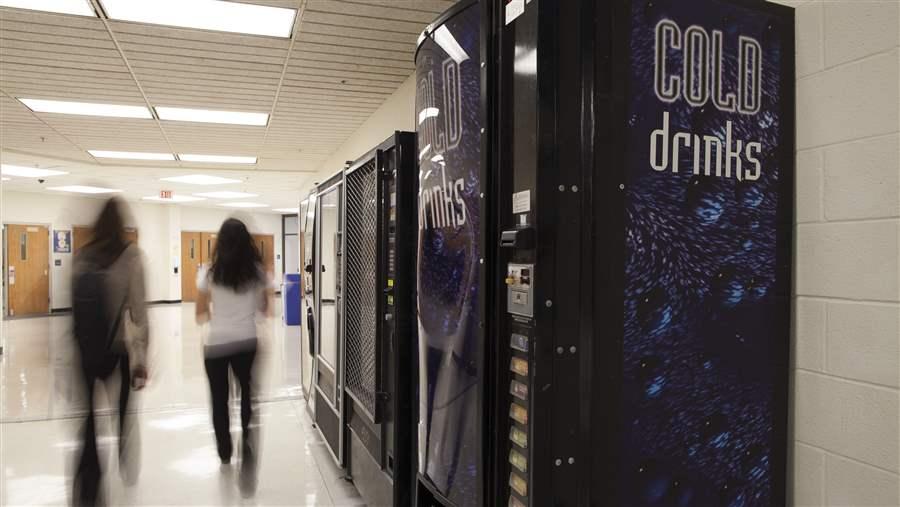USDA Issues Final Rules Supporting Healthy School Snacks and Wellness Policies
 © The Pew Charitable Trusts
© The Pew Charitable TrustsFinal school nutrition rules announced today are intended to ensure that students have healthy snack and beverage choices and that schools maintain policies to promote children’s well-being.
The U.S. Department of Agriculture released two final rules July 21 that mean schools must continue to meet strong nutrition guidelines for snacks sold to kids and also will prevent marketing of foods and drinks inconsistent with those standards.
Known as the Smart Snacks in School standards and the Local School Wellness Policy rule, these measures complement updated school meal nutrition standards that have been phased in since 2012. Together, the policies will help educators, parents, and students promote nutritious eating campuswide, not just in school cafeterias. Studies show that poor nutrition can negatively affect academic achievement. The newly finalized rules are important steps in ensuring that schools do all they can to support kids’ health and ability to learn.
Incorporating the latest nutrition guidance
The Smart Snacks standards took effect as interim measures in the 2014-15 school year, prompting school districts to offer healthier food and beverages in vending machines, school stores, and a la carte cafeteria lines. Fruits, vegetables, water, and hundreds of nutritious snack products now fill these venues instead of the candy, sodas, and other unhealthy items that were commonplace less than a decade ago. The USDA’s final rules give districts and their suppliers certainty about the Smart Snacks requirements and further demonstrate the agency’s attentiveness to both the latest nutrition science and schools’ feedback. For example, a new provision exempts eggs from the limit on total and saturated fat, a restriction that had frustrated some food service directors.
Strengthening goals and accountability
School wellness policies are not a new idea. In 2004, Congress passed a child nutrition law that required all districts participating in the National School Lunch Program to establish a local school wellness policy. Such policies grew out of concern over rising rates of childhood obesity and related conditions, including Type 2 diabetes in children.
Today, 95 percent of districts nationwide have a wellness policy in place; however, research shows that those policies vary substantially in their comprehensiveness and strength. The 2004 law provided minimal guidance on how to develop the policies or what they should include. It also lacked requirements that school districts evaluate and publicly report their results. Congress directed USDA to clarify these matters when lawmakers approved the Healthy, Hunger-Free Kids Act of 2010.
In the final rule, the USDA addressed these gaps—and incorporated suggestions from the Kids’ Safe and Healthful Foods Project—by requiring that:
- Wellness policies should make clear that all food offered and marketed to students on campus during the school day—including at school fundraisers—must comply with the Smart Snacks in School nutrition standards.
- Districts must engage stakeholders, including parents, students, teachers, and food service staff, in the development and review of local wellness policies.
- Districts must assess compliance with their wellness policies and progress toward specific goals, and make those assessments public. Such reporting should be done at least once every three years.
- One or more school officials must be designated to oversee compliance with the wellness policy.
Involving the community
Many schools have used wellness policies as a conduit for broader change. For example, in its 2011 wellness policy, Farmington Area Public Schools in Minnesota set out to incorporate nutrition education into the curriculum in a hands-on, interdisciplinary manner. The district’s policy also required that all foods sold on school campus meet the Institute of Medicine’s recommended nutrition standards for meals and snacks—the same scientific guidance that informed the USDA’s updated rules.
Effective wellness policies attract supporters from throughout the community. In Farmington, local farmers made presentations to students, an area natural food co-op helped organize school fundraisers featuring healthy foods, and a youth advocacy group helped add more nutritious choices to the snack store.
The wellness policy spurred “great improvements in creating a healthier school environment,” Farmington’s school nurse Gail Setterstrom told the Centers for Disease Control and Prevention in 2014. “We also know that the work of changing a culture is slow and requires patience and persistence. But we are positioned for the long run to continue to make those changes.”
Get involved
Parents have always played a central role in shaping their kids’ eating habits, and many schools have long invited input from students’ families on food and beverage policies. The Local School Wellness Policy rule gives every parent an opportunity to influence the nutritional environment in their child’s district. It also provides other community stakeholders with a chance to learn about, and contribute to, schools’ plans to promote good health for all students.
The USDA’s final rules for local wellness policies and Smart Snacks further empower schools to cultivate positive change in kids’ eating habits. These updates reflect and build on the recent progress in schools across the U.S. and will help ensure that the healthy choice is an easy one for all students.
Jessica Donze Black directs the Kids’ Safe and Healthful Foods Project at the Pew Charitable Trusts.


This video is hosted by YouTube. In order to view it, you must consent to the use of “Marketing Cookies” by updating your preferences in the Cookie Settings link below. View on YouTube
This video is hosted by YouTube. In order to view it, you must consent to the use of “Marketing Cookies” by updating your preferences in the Cookie Settings link below. View on YouTube


Parents Want Healthy School Food
More than 30 million American children eat school lunches each day, and these meals are healthier than ever. See how school lunches have changed.
Watch the Video





